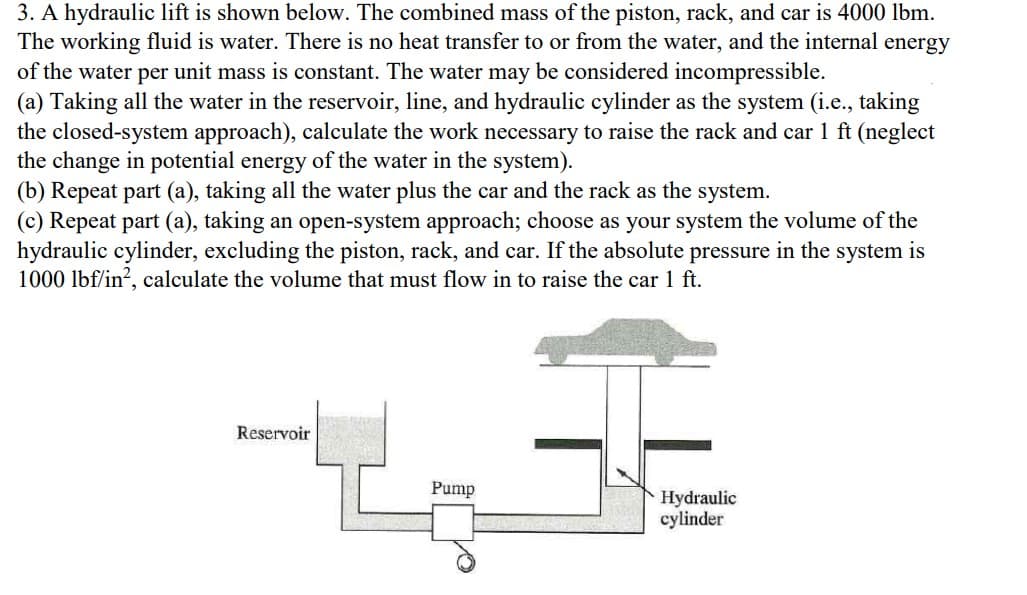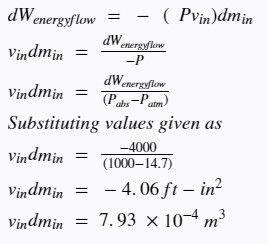he working fluid is water. There is no heat transfer to or from the water, and the f the water per unit mass is constant. The water may be considered incompressibl a) Taking all the water in the reservoir, line, and hydraulic cylinder as the system he closed-system approach), calculate the work necessary to raise the rack and ca he change in potential energy of the water in the system). b) Repeat part (a), taking all the water plus the car and the rack as the system. c) Repeat part (a), taking an open-system approach; choose as your system the vo
he working fluid is water. There is no heat transfer to or from the water, and the f the water per unit mass is constant. The water may be considered incompressibl a) Taking all the water in the reservoir, line, and hydraulic cylinder as the system he closed-system approach), calculate the work necessary to raise the rack and ca he change in potential energy of the water in the system). b) Repeat part (a), taking all the water plus the car and the rack as the system. c) Repeat part (a), taking an open-system approach; choose as your system the vo
Elements Of Electromagnetics
7th Edition
ISBN:9780190698614
Author:Sadiku, Matthew N. O.
Publisher:Sadiku, Matthew N. O.
ChapterMA: Math Assessment
Section: Chapter Questions
Problem 1.1MA
Related questions
Question
100%

Transcribed Image Text:3. A hydraulic lift is shown below. The combined mass of the piston, rack, and car is 4000 lbm.
The working fluid is water. There is no heat transfer to or from the water, and the internal energy
of the water per unit mass is constant. The water may be considered incompressible.
(a) Taking all the water in the reservoir, line, and hydraulic cylinder as the system (i.e., taking
the closed-system approach), calculate the work necessary to raise the rack and car 1 ft (neglect
the change in potential energy of the water in the system).
(b) Repeat part (a), taking all the water plus the car and the rack as the system.
(c) Repeat part (a), taking an open-system approach; choose as your system the volume of the
hydraulic cylinder, excluding the piston, rack, and car. If the absolute pressure in the system is
1000 lbf/in², calculate the volume that must flow in to raise the car 1 ft.
Reservoir
Pump
Hydraulic
cylinder
Expert Solution
This question has been solved!
Explore an expertly crafted, step-by-step solution for a thorough understanding of key concepts.
This is a popular solution!
Trending now
This is a popular solution!
Step by step
Solved in 4 steps

Follow-up Questions
Read through expert solutions to related follow-up questions below.
Follow-up Question
i think your part B in this solution is for part A, how do you solve for part B now that we have to take water into account
Solution
Follow-up Question
I am confused on the (-) & how u went from ft/in^2 to m^3

Transcribed Image Text:dw energyflow
vindmin
dWenergyflow
Vindmin
(Pabs-Patm)
Substituting values given as
- ( Pvin)dmin
dWenergyflow
-P
-4000
vindmin = (1000-14.7)
vindmin=-4.06
ft- in²
vindmin = 7.93 x 10-4 m³
Solution
Knowledge Booster
Learn more about
Need a deep-dive on the concept behind this application? Look no further. Learn more about this topic, mechanical-engineering and related others by exploring similar questions and additional content below.Recommended textbooks for you

Elements Of Electromagnetics
Mechanical Engineering
ISBN:
9780190698614
Author:
Sadiku, Matthew N. O.
Publisher:
Oxford University Press

Mechanics of Materials (10th Edition)
Mechanical Engineering
ISBN:
9780134319650
Author:
Russell C. Hibbeler
Publisher:
PEARSON

Thermodynamics: An Engineering Approach
Mechanical Engineering
ISBN:
9781259822674
Author:
Yunus A. Cengel Dr., Michael A. Boles
Publisher:
McGraw-Hill Education

Elements Of Electromagnetics
Mechanical Engineering
ISBN:
9780190698614
Author:
Sadiku, Matthew N. O.
Publisher:
Oxford University Press

Mechanics of Materials (10th Edition)
Mechanical Engineering
ISBN:
9780134319650
Author:
Russell C. Hibbeler
Publisher:
PEARSON

Thermodynamics: An Engineering Approach
Mechanical Engineering
ISBN:
9781259822674
Author:
Yunus A. Cengel Dr., Michael A. Boles
Publisher:
McGraw-Hill Education

Control Systems Engineering
Mechanical Engineering
ISBN:
9781118170519
Author:
Norman S. Nise
Publisher:
WILEY

Mechanics of Materials (MindTap Course List)
Mechanical Engineering
ISBN:
9781337093347
Author:
Barry J. Goodno, James M. Gere
Publisher:
Cengage Learning

Engineering Mechanics: Statics
Mechanical Engineering
ISBN:
9781118807330
Author:
James L. Meriam, L. G. Kraige, J. N. Bolton
Publisher:
WILEY